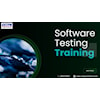How to Develop a Successful Corporate Training Strategy?
Postet av himanshi verma den 9. Okt 2025

Many organizations are investing in training to boost productivity, enhance technical expertise, and build leadership capabilities of their employees. But not every training program delivers results. The real success lies in developing a customized corporate training strategy that aligns with your company's goals and workforce needs.
Identify Training Needs Clearly
First of all, identify the exact skills your employees need to grow before taking enterprise training. Conduct skill assessments, performance reviews, and surveys to uncover knowledge gaps. A clear understanding of current versus desired skills helps in designing a relevant and effective training strategy.
Align Training Goals with Business Objectives
Every training initiative must directly support organizational goals such as increasing efficiency, improving client satisfaction, or driving innovation. Aligning programs with company priorities ensures that your investment generates measurable outcomes through corporate training in Noida.
Choose the Right Training Methods
Different teams require different training formats. Technical employees might benefit from hands-on workshops, while managers may prefer leadership seminars or scenario-based learning. A mix of online sessions, classroom learning, and project-based training works best. CETPA Infotech is known as one of the Best IT Training Institutes, which combines real-world case studies with live project experience to make employees job-ready faster.
Customize Training Programs
Every organization has a unique culture, workforce and growth plan. Customize your corporate training to address your company's specific challenges. Personalized learning paths increase engagement and retention. Tailored content keeps participants interested and also ensures that what they learn can be immediately applied at work.
Focus on Continuous Learning
Successful companies view training as an ongoing process. Encourage employees to engage in continuous learning through refresher sessions, advanced modules, and mentorship programs. Platforms offering enterprise training often include skill-tracking tools to monitor progress and suggest new learning opportunities. This helps organizations create a culture where learning never stops.
Leverage Technology for Better Outcomes
Modern training programs rely on technology to make learning more flexible and effective. Using Learning Management Systems (LMS), virtual labs, and online assessments allows employees to learn at their own pace. Companies investing in corporate training in Bangalore are increasingly adopting hybrid learning models to blend convenience with interaction.
Measure Training Effectiveness
Track metrics like employee performance, productivity improvements, and ROI after each program. Data-driven insights help you refine future training sessions and justify the value of your investment. Feedback forms, post-training assessments, and on-the-job evaluations reveal whether the training truly worked.
Conclusion
A corporate training strategy can transform your workforce into a powerful asset that drives innovation and growth. By aligning learning goals with business objectives, leveraging technology, and partnering with trusted experts, your organization can stay ahead in the competitive market.
Kommentarer
Logg inn for å skrive en kommentar.


